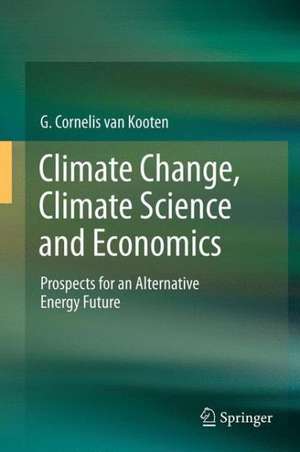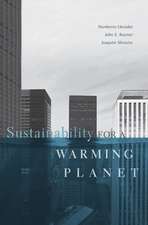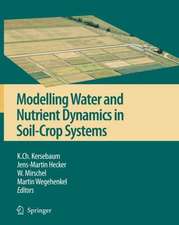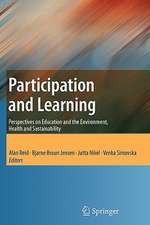Climate Change, Climate Science and Economics: Prospects for an Alternative Energy Future
Autor G. Cornelis van Kootenen Limba Engleză Paperback – 21 sep 2014
Readers will also learn that global warming cannot easily be avoided by reducing CO2 and other greenhouse gas emissions in rich countries. Not only is emissions reduction extremely difficult in rich countries, but demands such as the UN mandate to improve the lives of the poorest global citizens cannot be satisfied without significantly increasing global energy use, and CO2 emissions. Therefore, the author asserts that climate engineering and adaptation are preferable to mitigation, particularly since the science is less than adequate for making firm statements about the Earth’s future climate.
Readers will also learn that global warming cannot easily be avoided by reducing CO2 and other greenhouse gas emissions in rich countries. Not only is emissions reduction extremely difficult in rich countries, but demands such as the UN mandate to improve the lives of the poorest global citizens cannot be satisfied without significantly increasing global energy use, and CO2 emissions. Therefore, the author asserts that climate engineering and adaptation are preferable to mitigation, particularly since the science is less than adequate for making firm statements about the Earth’s future climate.
| Toate formatele și edițiile | Preț | Express |
|---|---|---|
| Paperback (1) | 953.65 lei 6-8 săpt. | |
| SPRINGER NETHERLANDS – 21 sep 2014 | 953.65 lei 6-8 săpt. | |
| Hardback (1) | 967.08 lei 6-8 săpt. | |
| SPRINGER NETHERLANDS – 31 aug 2012 | 967.08 lei 6-8 săpt. |
Preț: 953.65 lei
Preț vechi: 1162.99 lei
-18% Nou
Puncte Express: 1430
Preț estimativ în valută:
182.51€ • 189.83$ • 150.67£
182.51€ • 189.83$ • 150.67£
Carte tipărită la comandă
Livrare economică 15-29 aprilie
Preluare comenzi: 021 569.72.76
Specificații
ISBN-13: 9789401781169
ISBN-10: 9401781168
Pagini: 492
Ilustrații: XXIV, 468 p.
Dimensiuni: 155 x 235 x 26 mm
Greutate: 0.68 kg
Ediția:2013
Editura: SPRINGER NETHERLANDS
Colecția Springer
Locul publicării:Dordrecht, Netherlands
ISBN-10: 9401781168
Pagini: 492
Ilustrații: XXIV, 468 p.
Dimensiuni: 155 x 235 x 26 mm
Greutate: 0.68 kg
Ediția:2013
Editura: SPRINGER NETHERLANDS
Colecția Springer
Locul publicării:Dordrecht, Netherlands
Public țintă
ResearchCuprins
1. Introduction.- 2. Weather and the Instrumental Record.- 3. Climate Science and Paleoclimatology.- 4. Emission Scenarios and Climate Modeling.- 5. Alternative Explanations.- 6. How Economists Measure Wellbeing: Social Cost-Benefit Analysis.- 7. Economic Assessment of the Damages Caused by Global Warming.- 8. Implementing Policy.- 9. Avoiding Emissions Reduction: Terrestrial Carbon Sinks.- 10. Economic Growth, Energy and Climate Change.- 11. Electricity Markets and Wind Energy.- 12. Climate Change Policy Encounters the Real World.- Index.
Recenzii
From the reviews:
“The book begins with mathematical modeling of both environmental and economic factors associated with global climate change. The well-produced volume is packed with documentation, tables, figures, equations, and commentary. … The author offers clear, incisive assessments of models and policy responses to climate change. … provides a wealth of factual data, economic relationships, and provocative ideas. It is the best available devil’s advocate resource for advanced students, experts, and practitioners in the area of climate science and policy. Summing Up: Recommended. Graduate students and above.” (F. T. Manheim, Choice, Vol. 50 (7), March, 2013)
“The book begins with mathematical modeling of both environmental and economic factors associated with global climate change. The well-produced volume is packed with documentation, tables, figures, equations, and commentary. … The author offers clear, incisive assessments of models and policy responses to climate change. … provides a wealth of factual data, economic relationships, and provocative ideas. It is the best available devil’s advocate resource for advanced students, experts, and practitioners in the area of climate science and policy. Summing Up: Recommended. Graduate students and above.” (F. T. Manheim, Choice, Vol. 50 (7), March, 2013)
Textul de pe ultima copertă
Is anthropogenic global warming occurring? Perhaps, says the author, although an examination of the evidence suggests that it will not be catastrophic and reality tells us that, despite significant expenditure on mitigating climate change, we had better learn to adapt to it.
This volume is a comprehensive examination of why this is the case, enabling readers to understand the complexity associated with climate change policy and the science behind it. For example, the author describes the criticism and defense of the widely known “hockey stick” temperature graph derived from combining instrumental data and proxy temperature indications using tree ring, ice core and other paleoclimatic data.
Readers will also learn that global warming cannot easily be avoided by reducing CO2 and other greenhouse gas emissions in rich countries. Not only is emissions reduction extremely difficult in rich countries, but demands such as the UN mandate to improve the lives of the poorest global citizens cannot be satisfied without significantly increasing global energy use, and CO2 emissions. Therefore, the author asserts that climate engineering and adaptation are preferable to mitigation, particularly since the science is less than adequate for making firm statements about the Earth’s future climate.
The purpose of the book is not only to inform but to get the reader thinking critically about what may well be the most important environmental issue currently facing humankind.
This volume is a comprehensive examination of why this is the case, enabling readers to understand the complexity associated with climate change policy and the science behind it. For example, the author describes the criticism and defense of the widely known “hockey stick” temperature graph derived from combining instrumental data and proxy temperature indications using tree ring, ice core and other paleoclimatic data.
Readers will also learn that global warming cannot easily be avoided by reducing CO2 and other greenhouse gas emissions in rich countries. Not only is emissions reduction extremely difficult in rich countries, but demands such as the UN mandate to improve the lives of the poorest global citizens cannot be satisfied without significantly increasing global energy use, and CO2 emissions. Therefore, the author asserts that climate engineering and adaptation are preferable to mitigation, particularly since the science is less than adequate for making firm statements about the Earth’s future climate.
The purpose of the book is not only to inform but to get the reader thinking critically about what may well be the most important environmental issue currently facing humankind.
Caracteristici
Offers a critical examination of the science behind climate change policy Presents a comprehensive understanding of the world's energy-environmental dilemma Identifies policies that are effective in adapting to and managing climate change


















